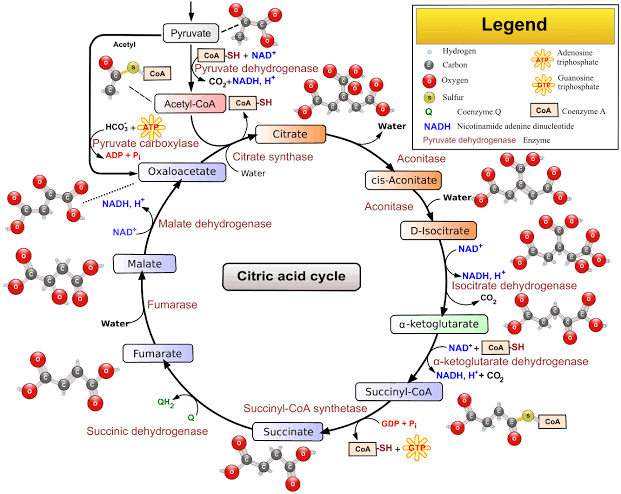
What is the rate limiting step of the TCA cycle?
Answer
393k+ views
Hint: TCA or tricarboxylic cycle or Krebs cycle or citric acid cycle was discovered by H.A. Krebs. The location where the TCA cycle occurs is the mitochondrial matrix, mitochondria is also called the powerhouse of the cell. All the enzymes of the TCA cycle, except the marker enzyme Succinic dehydrogenase present in the matrix (on the inner mitochondrial membrane).
Complete answer:
The TCA cycle could also be a central pathway that provides a unifying point for several metabolites, which feed at various points. It takes place in eight different steps:
Step 1: Acetyl CoA (two carbon) combines with oxaloacetate (4 carbon) to form citrate (6 carbon).
Step 2: Citrate is converted to isocitrate which is an isomer of citrate.
Step 3: Isocitrate is oxidised to alpha-ketoglutarate which is a five-carbon molecule and it finishes up within the discharge of
The enzyme which is used for catalysing this step is isocitrate dehydrogenase and this is a rate limiting step as isocitrate dehydrogenase enzyme controls the reaction allosterically.
Step 4: Alpha-ketoglutarate is oxidised to make a 4 carbon molecule and this molecule binds to coenzyme A and forms succinyl CoA. A second molecule of NADH is produced, alongside a second molecule of
Step 5: Succinyl CoA is then converted to 4 carbon molecules 'succinate' and one GTP molecule is produced.
Step 6: Succinate is converted into fumarate which is a 4 carbon molecule and a molecule of FADH₂ is produced.
Step 7: Fumarate is converted to malate which is also 4 carbon molecules.
Step 8: Malate is then converted into oxaloacetate. The third molecule of NADH is produced.
So step 3 is the rate limiting step in the TCA cycle.

Note:
It is important to remember that as the first role of the TCA cycle is production of NADH and FADH₂, it also produces molecules that provide various biosynthetic processes. These enter or exit the cycle at various points, counting on demand. For example, alpha-ketoglutarate can leave the cycle to be converted into amino acids, and succinates are often converted to haem.
Complete answer:
The TCA cycle could also be a central pathway that provides a unifying point for several metabolites, which feed at various points. It takes place in eight different steps:
Step 1: Acetyl CoA (two carbon) combines with oxaloacetate (4 carbon) to form citrate (6 carbon).
Step 2: Citrate is converted to isocitrate which is an isomer of citrate.
Step 3: Isocitrate is oxidised to alpha-ketoglutarate which is a five-carbon molecule and it finishes up within the discharge of
The enzyme which is used for catalysing this step is isocitrate dehydrogenase and this is a rate limiting step as isocitrate dehydrogenase enzyme controls the reaction allosterically.
Step 4: Alpha-ketoglutarate is oxidised to make a 4 carbon molecule and this molecule binds to coenzyme A and forms succinyl CoA. A second molecule of NADH is produced, alongside a second molecule of
Step 5: Succinyl CoA is then converted to 4 carbon molecules 'succinate' and one GTP molecule is produced.
Step 6: Succinate is converted into fumarate which is a 4 carbon molecule and a molecule of FADH₂ is produced.
Step 7: Fumarate is converted to malate which is also 4 carbon molecules.
Step 8: Malate is then converted into oxaloacetate. The third molecule of NADH is produced.
So step 3 is the rate limiting step in the TCA cycle.

Note:
It is important to remember that as the first role of the TCA cycle is production of NADH and FADH₂, it also produces molecules that provide various biosynthetic processes. These enter or exit the cycle at various points, counting on demand. For example, alpha-ketoglutarate can leave the cycle to be converted into amino acids, and succinates are often converted to haem.
Recently Updated Pages
Master Class 11 Economics: Engaging Questions & Answers for Success

Master Class 11 Business Studies: Engaging Questions & Answers for Success

Master Class 11 Accountancy: Engaging Questions & Answers for Success

Master Class 11 English: Engaging Questions & Answers for Success

Master Class 11 Computer Science: Engaging Questions & Answers for Success

Master Class 11 Maths: Engaging Questions & Answers for Success

Trending doubts
Which one is a true fish A Jellyfish B Starfish C Dogfish class 11 biology CBSE

State and prove Bernoullis theorem class 11 physics CBSE

1 ton equals to A 100 kg B 1000 kg C 10 kg D 10000 class 11 physics CBSE

In which part of the body the blood is purified oxygenation class 11 biology CBSE

One Metric ton is equal to kg A 10000 B 1000 C 100 class 11 physics CBSE

Difference Between Prokaryotic Cells and Eukaryotic Cells




